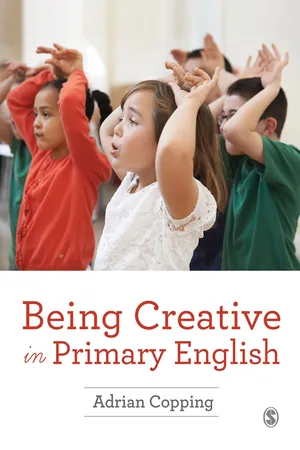Chapter overview
The Introduction makes a case for creativity, drawing attention to some definitions and also to the three key elements of creativity in the title of this chapter. This chapter explores the concepts of creative thinking, teaching and integration in more depth and connects to definitions of creativity. Drawing on seminal work from leading writers on creative thinking, this chapter will explore different models of creative thinking, techniques and possible applications linked to inclusive pedagogy and its benefits for children. The chapter will outline some of the differences between critical thinking and creative thinking and suggest that, although much of how we teach encourages critical thinking, it does not do the same for creative thinking. This chapter will also look to ‘myth-bust’ creative teaching and explore teaching for creativity as well as presenting models for the integration of subjects, primarily drawing on the work of Robin J. Fogarty. There will also be connections made between the concepts and application of classroom approaches, outlining some different techniques and ideas. The concepts in this chapter are then exemplified by primary English teaching throughout the rest of the book.
Creative thinking: the concept of thinking
First, it is important to say that creative thinking and critical thinking are both equally as important. Fisher (1992) states that the concept of thinking is derived from the disciplines of philosophy and psychology. Philosophy is more concerned with the study of critical thinking, relying on and putting forward the merits of analysis and argument and applying logic to situations, whereas Cognitive Psychology (the study of mental processes and the role they play in how people think, feel and behave) gives more emphases to creative thinking and how ideas are formed in the mind. Thinking involves both these aspects. We cannot make sense of the world unless we think, unless we apply logic to situations, unless we analyse situations. But we cannot pursue ideas, we cannot create new things, we cannot have new ideas unless we allow and imagine them to be formed in our minds. Our thinking, however, is not something that we do in a vacuum. Despite the fact that we may often think by ourselves, I usually do a lot of thinking whilst cycling to and from work, Fisher would argue that our thinking is ‘mediated by others’ (1992: 4). He goes on to suggest that thinking takes place within a social context; it is shaped by the culture we are operating in and the environment in which we find ourselves.
These are not the only disciplines that facilitate the study of thinking. Our understanding of neuroscience has massively increased over the last decade and our knowledge of how the brain works on a physiological level and what it can do is significantly advanced. Humans have been fascinated by the brain for a long time, however. Phrenology, an aspect of science that focuses on measuring parts of the skull, linking to the brain having separate areas and functions, was a popular hobby during the latter part of the nineteenth century. This led to the search for general laws about how the mind works, looking for universal patterns in, as Fisher states, ‘cognitive growth and human knowing’ (1992: 5). Fisher also cites the contribution of Francis Galton (1822–1911), who devised a method for ranking human beings in terms of their physical and intellectual attributes. He suggested that genius was hereditary and that if your mind was superior in one aspect, it would be superior in all. If this is the case, then what is the point in self-improvement and learning? These findings led to questions around whether intelligence is part of a child’s nature or can it be nurtured?
I have just made a connection above between intelligence and the ability to think – which I must confess has significant limitations. The measure of both is very important. Craft (2000) cites the work of Hudson (1973), who made the suggestion that children who excel in disciplines that look for one right answer also do well in traditional IQ tests. In other words, these children are good at convergent thinking. So, the text that measured intelligence actually measured the ability to find the correct answer. Drawing again on Hudson (1973), Craft (2000) goes on to suggest that children who are good at thinking divergently, tend to excel in the arts-based disciplines. Taking this line of thinking to its conclusion could lead us to arrive at the misconception that thinking divergently is creative and therefore applies to the arts and thinking convergently is not creative and applies to science-led disciplines. However, I want to make very clear that this is a huge misconception, certainly in terms of thinking. Guilford (1967) brought to light the distinction between different types of thinking: convergent, being about looking for the one right answer; and divergent, looking for a myriad of possible answers. These apply to any area and any discipline and should not be pigeonholed in this way. Thinking transcends subject disciplines. I also want to make very clear that I am not suggesting that divergent thinking is in any way better than convergent thinking, it is, however, more creative. Craft states: ‘possibility thinking, which is the basis of creativity, is involved in both convergent and divergent thinking’ (2000: 7).
Possibility thinking
Possibility thinking is an aspect of divergent thinking. So, what is meant by possibility thinking? Craft puts it ‘at the heart of all creativity in young children’ (2007: 1) and it is all about generating lots of possibilities. Guilford (1967) asked how many uses could be found for a pen; Craft would suggest that possibility thinking is about going even further and asking ‘what if’ questions. What if the pen was the size of a house and made of foam? What if it was made of wood and the size of a woodlouse? What if it was rolled out to make a flat surface? How many uses could be found for the pen?
The case study below explores possibility thinking in action in a Year 4 class looking at forces. Note how Josh, the class teacher, encourages his class to suggest and try out different possibilities. Where does the learning take place?
Case study
Josh, a Year 4 teacher, was teaching a unit of work on forces. He was focusing on friction and air resistance. Many of Josh’s class were interested in Formula 1 motor racing, so Josh decided to turn his classroom into a Formula 1 pit lane garage as a means of stimulating interest. Josh’s challenge to his class was clear. He asked them to design and build a car that would be able to go as far as possible unaided from a downhill ramp start. Josh discussed with his class how they would go forward with this. For Josh, the main focus was learning about friction and air resistance, not about creating a beautifully neat car to show to parents. He was hoping for experimentation and a range of ideas, and that is what he got.
As the project developed, Josh observed a lot of discussion around the car’s weight and shape and that more weight would provide more downward force. These were children whom Josh would not have expected to be discussing this kind of complexity. Children were suggesting alternative materials, alternative aerodynamic designs, different widths, lengths, shapes and wheel sizes. What would the children do, however, if something didn’t work? Although this hadn’t really been planned, Josh found that, in the main, the children worked collaboratively quite effectively and sought support from each other. Billy would help Hannah to alter something to help her car go faster. Mel would ask Michael for help when she didn’t know why her car got stuck at the bottom of the ramp. The evaluation of the cars was taking place during the design process – those complex skills of refining and evaluating were happening naturally.
Reflecting on the case study
- How did Josh facilitate possibility thinking?
- What are some of the challenges of Josh’s approach? Was there any scaffolding?
- What type of work had gone before for Josh’s class to respond as they did?
- What did the children learn, and during which aspects of the project did it take place?
- What will you take from this case study?
Craft states that: ‘Possibility thinking, then, essentially involves a transition in understanding; in other words, the shift from “What is this?” to exploration – i.e. “What can I/we do with this?” Fostering possibility in children involves enabling children to find and refine problems as well as to solve them’ (2007: 2). It would have been easy for Josh to have provided some aerodynamic cutouts for the children to fold, wood and wheels cut to the right lengths and a neat presentation to show the children how to make the best car. But, where would the learning have been? Possibility thinking for Josh was about the children working out what to do with the problem and then uncovering any issues and dealing with them as the process unfolded. This is helping children develop...

